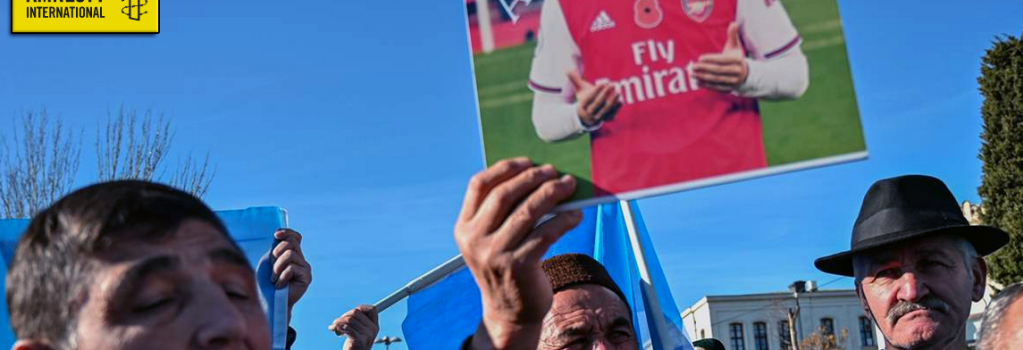By Nicholas Bequelin, Regional Director at Amnesty International
Mesut Ozil’s social media post about the political situation in Xinjiang Uyghur Autonomous Region has prompted an angry response from the Chinese authorities. The Arsenal footballer’s accusation that China is persecuting the predominantly Muslim Uyghur minority has been dismissed by Beijing as “fake news”. Meanwhile, a Gunners match was pulled from the state TV schedule and Chinese football fans have reportedly burned Arsenal shirts in protest at the player’s comments.
Amnesty International has extensively documented the situation in Xinjiang Uyghur Autonomous Region over the past several years. We have interviewed more than 400 people outside of China whose relatives in Xinjiang are still missing, as well as individuals who said they were tortured while in detention camps there. We also collected satellite photos of the camps and analysed official Chinese documents that detail the mass-internment programme. This is what is really happening:
1 Mass internment camps
An estimated one million predominantly Muslim people, such as Uyghurs and Kazakhs, have been held in internment camps in Xinjiang, northwest China. The government has repeatedly denied the existence of the camps – describing them instead as voluntary “transformation-through-education” centres. But those sent there have no right to challenge the decision.
2 Harsh conditions
Kairat Samarkan was among those sent to a detention camp in October 2017, after he returned to Xinjiang from Kazakhstan. He told Amnesty he was hooded, made to wear shackles on his arms and legs and forced to stand in a fixed position for 12 hours when first detained. He said detainees are also forced to sing political songs and chant “Long live Xi Jinping” (the Chinese president) before meals or face harsh punishment.
3 Detainees driven to the brink
The authorities decide when detainees have been “transformed”. Those who resist or fail to show enough progress face punishments ranging from verbal abuse to food deprivation, solitary confinement and beatings. There have been reports of deaths inside the facilities, including suicides of those unable to bear the mistreatment.
4 Information blackout
The Chinese authorities have invited Mesut Ozil to come to Xinjiang and “have a look” at the situation for himself. This is a trap: the government has organized dozens of Potemkin-style propaganda tours for unwitting foreigners while preventing independent UN experts from visiting the region, harassing foreign journalists and instructing local officials to keep the mass detention programme secret.
5 China’s ‘anti-terror’ argument
The Chinese government has justified its extreme measures as necessary to prevent religious “extremism” and what they claim are “terrorist activities”. Their stance on Xinjiang’s ethnic minorities has hardened since a series of violent incidents in the capital Urumqi in 2009 and the knife attacks at Kunming railway station in southwest China in 2014. This hardly justifies the arbitrary detention of hundreds of thousands of people. In fact, UN experts concluded last month that China’s policies in Xinjiang were actually likely to “worsen any security risk”.
6 Arrested for growing a beard
The persecution of Xinjiang’s Muslims has intensified since a regulation passed in 2017 meant people could be labelled “extremist” for reasons such as refusing to watch public TV programmes or having an “abnormal” beard. Wearing a veil or headscarf, regular prayer, fasting or avoidance of alcohol can also be considered “extremist” under the regulation.
7 Surveillance state
Everyone in Xinjiang is at risk of being detained. The region is blanketed with facial-recognition surveillance cameras, backed by the use of artificial intelligence and mass DNA collection. Ubiquitous security checks are a part of daily life, with the authorities searching mobile phones for suspicious content.
People might also come under suspicion through routine monitoring of messages sent on social media apps such as WeChat. Syrlas Kalimkhan said he installed WhatsApp on his father’s phone and tested it by texting, “Hi, Dad.” Later, the police asked his father why he had WhatsApp on his phone. He was later sent to a “re-education camp”.
8 Relatives scared to speak out
Most of the detainees’ families have been kept in the dark about their fate, while those who speak out risk being detained themselves. To avoid arousing such suspicion, Uyghurs, Kazakhs and others inside Xinjiang have been cutting ties with friends and family living outside China. They warn acquaintances not to call and delete outside contacts from social media applications.
9 A dark echo of the past
The camps are places of brainwashing, torture and punishment that hark back to the darkest hours of the Mao era, when anyone suspected of not being loyal enough to the state or the Chinese Communist Party could end up in China’s notorious labour camps. Muslim ethnic minority groups in Xinjiang are living in permanent fear for themselves and their detained relatives.
10 An important stand
While Arsenal have been criticized for not speaking out in support of Ozil, companies do not technically have a responsibility to denounce human rights violations. They only have to ensure they do not cause, contribute to or profit from such abuses.
Yet China’s attempts to impose its powerful censorship abroad must be resisted. Ozil has taken an important stand in speaking out in support of those facing brutal persecution in Xinjiang – and his intervention has raised global awareness of one of the gravest human rights crises of our time. Arsenal are entitled to remain silent, but Ozil’s right to freedom of expression must be preserved.
A version of this article was originally published by The Independent
Source: amnesty.org

Leave a Reply